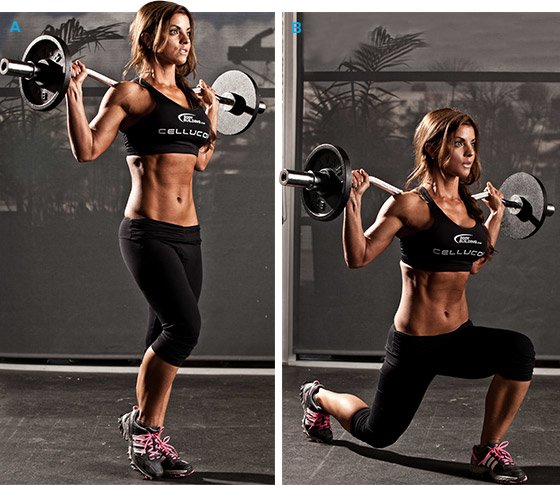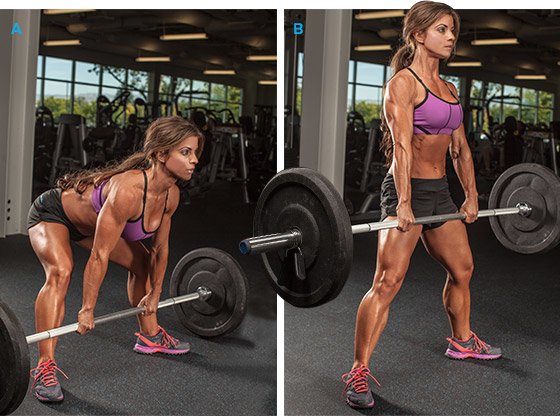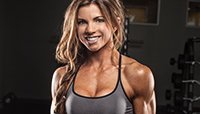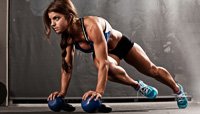I know squats are important for building a great butt, but some injuries prevent me from doing them. Do you have any good squat alternatives or even a squat-free booty workout?
In general, the rule in the gym is "if it hurts, don't do it." If your back or hips are immobile or injured, loading heavy weight on your back and trying to squat it may be a bad idea. Although there's no doubt about the efficacy of squats for booty-building, sometimes they're just not in the cards.
Have no fear, though! Even if you must avoid the squat rack due to injuries, you can still achieve the ultimate set of glutes. There are many other fun and challenging exercises that will build and shape buns of steel.
Just 10-15 reps of the following exercises will stimulate your glutes from all angles. Mix and match them on your leg or glute days, or include them in your full-body circuits. Do them correctly and frequently and you'll build a round, full bum that looks great in a bikini or even a pair of jeans.
Let's go booty-building!
Ode to the lunge
A fantastic alternative to the squat is the lunge. Although there are about a million variations, most lunges have the same basic setup: one leg is forward with the knee bent and the other leg is behind. You can do them without weight, or you can hold a barbell, dumbbells, or even kettlebells.
Lunges build and shape your quads, hamstrings, and butt. The farther forward you step your front foot, the more your butt and hamstrings will have to work. A shorter step will emphasize your quads. Lunges are also great for stretching out those hip flexors—if you sit all day, yours are probably short, tight, and weak. Lunges will also work those oft-forgotten hip adductors and abductors that are so important to stability and athletic performance.
Here are a few of my favorite types of lunges. You can add a few sets to your leg day and enjoy the benefits.

Barbell Lunge
Walking lunge
Grab a barbell or set of dumbbells and go for it. Walking lunges differ from stationary lunges in that you have to use your already-taxed front leg to step forward instead of pushing backward into a standing position. The trailing leg is mostly just for stability.
Although stationary lunges are great for leg and butt development, I prefer walking lunges because they hit that forward leg a little harder. Remember to reach forward with your front leg to better activate your butt and hamstrings. Do enough reps to feel the burn!
Reverse lunge from deficit
Deficit lunges are great for building better glutes and hammies, because those muscles actually initiate the movement. Because you're working from a deficit, your hips have to work harder to drive your body upward, which places more emphasis on your backside.
There's no need to lunge backward from a cliff, here. A 2-4 inch deficit will be plenty.
Start with both feet on the step and step back with one of your legs. Make sure you step back far enough so you can go low to engage your glutes and hamstrings. Push your weight through your heels as you power back up.
Make sure you train each leg evenly and do your best to keep your spine straight and your head neutral throughout the movement.
Curtsy lunge
This variation of lunge is great because well, you get to curtsy, and you get to work on building an awesome butt! The curtsy lunge hits your glute medius—one of your glute muscles that helps pull your legs away from the midline of your body—and also strengthens your abductors and adductors.
The movement is a little strange, so it's best to practice without weight until you feel comfortable. Start standing with your feet shoulder-width apart. Bring your left foot behind and across your body as you lunge downward. Both knees should be at about 90 degrees.
Try to keep your front knee from going too far over your toes. If it's difficult to balance, use a wall for stability until you feel ready to do them on your own.
Other great butt-building moves
Sumo deadlift
I absolutely love sumo deadlifts! They're awesome because they help us emphasize the weakest parts of our bodies. When doing conventional deadlifts, most people use their lower backs and their quads to assist with the lift. The sumo deadlift basically removes your quads and lower back from the picture so you're left relying on your hips, glutes, and hamstrings to do the pulling. If you have a history of back problems, then sumo deadlifts are your friend.
Although they're great on paper, sumo deads can be difficult. To do them correctly, set up with a 45-degree foot flare and your shins touching the bar. Your legs should be wide. This external rotation of your hips will help you engage the hips during your pull. Your knees need to be turned outward to match your feet. If your knees cave inward, you're in the market for an injury.

Sumo deadlift
Don't squat down, but try to keep your hips relatively high. Reach your arms straight down and grab the bar. Your chest should be up, your spine and head neutral, and your core tight.
It doesn't matter if you're a 50-year-old woman or a 23-year-old guy, deadlifts need to be part of your program. You don't have to go super heavy, but lift enough weight to challenge your glutes to grow.
Glute bridge and hip thrust
Glute bridges and hip thrusts are the ultimate glute builders and shapers. If you want a better booty, you can't have a routine without these exercises in it.
The glute bridge is a beginner exercise. I suggest you start with it until you can master the feel of the movement and understand how best to activate your glutes.
To perform a glute bridge, lie on the floor with your knees bent and your feet shoulder-width apart. Your feet should be about six inches away from your butt. Use your glutes to raise your hips in the air and squeeze at the top. You should concentrate on using your glutes and nothing else.
Hip thrusts are a little more difficult because the range of motion is larger. Do them with your upper back against a bench and your feet a little farther out in front of you. At the top of the movement, you should be able to draw a straight line from your knees through your hips and to your shoulders.
If you want to make these more difficult, you can roll a barbell onto your hips for resistance. Your glutes will have to work extra hard to move the weight up!
Plie squat
Plie squats aren't just for the ballerina in you. This squat variation is perfect for people with lower-back injuries: There's no stress on the back, but you still get to be in the ultra-effective squat position.
To do a plie squat, stand with your feet wide and your toes pointed out, much like the starting position in a sumo deadlift. The key to making plie squats work for your butt is to concentrate on using your glutes to push yourself back up out of the hole. If you want to use weight, hold a kettlebell, dumbbell, or two in front of you. Be sure to keep your back straight and your chest up.
You should feel some excellent stretching in your hips when you do this movement.
Cardio Bursts
I love to add in cardio bursts to my lower-body training. Between sets of weighted exercises, I'll throw in sets of plyometrics—burpees, mountain climbers, jump squats, and more—to get that extra burn. You can also keep it simple by jumping rope between sets.
Cardio bursts between sets of resistance exercises keep your heart rate elevated so you can burn more fat, which will help you uncover that crazy-awesome booty in no time!

Recommended For You

Be An Alpha Girl: 5 Tips To Better Workouts And More Self Confidence
The rank of alpha is reserved for the boldest, baddest girl in the gym. If you want to be that girl, apply these 5 tips to your workout regimen today.
Lovely Lady Legs: Jen Jewell's Leg-Sculpting Workout
Don't hide your legs this winter, display them! Build your legs and burn some fat with Jen's intense lower-body workout.

